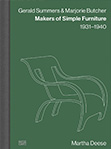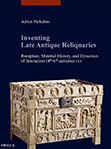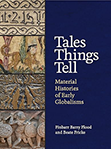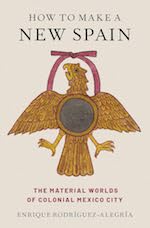
-

-

This ambitious book, the fruit of a doctoral dissertation approved by the universities of Fribourg and Brno in 2019, seeks to explain how relic containers figured in the controversial Christian practice of dispersing the bodily remains of holy persons to communities far from their places of burial.
-

Through six extensive case studies, this fascinating book unpacks and eruditely fleshes out early globalisms in material and object-oriented terms, demonstrating how such an emphasis and the perspective of art history can enhance the currently expanding field of global history.
-

Readers of Enrique Rodríguez-Alegría’s earlier The Archaeology and History of Colonial Central Mexico (Cambridge, 2016) will reencounter familiar themes in this recent book.
-

Time has long been a central concern of both archaeology and philosophy. For Plato, time was an absolute external reality. Aristotle, instead, emphasized the relative temporal relations between events.
-

The Art of Cloth in Mughal India begins with an intriguing seventeenth-century hand-painted, mordant, and resist-dyed cotton wall hanging depicting traders, hunters, aristocrats, and monarchs from diverse parts of an early modern world intimately linked by Indian Ocean trade.
-

This book can be described as an extended essay on perception and mentality in the medieval Islamic world in relationship to objects.
-

When did colonial America begin? This is the polemical question Byron Ellsworth Hamann sets out to answer in his immensely erudite and lavishly illustrated The Invention of the Colonial Americas: Data, Architecture, and the Archives of the Indies, 1781–1844.
-

Stone, and especially marble—in the broad, ancient, and traditional sense of a veined stone lending itself to be carved and polished—is a topical subject in the history of art and architecture.
-

Though the original Danish version of this book was published in 2006, sustained interest in Scandinavian mid-century modern design in popular and academic circles makes this new, expanded English edition most welcome.
-

Dan Hicks’s book is true to the period of its subject for he has written a Victorian melodrama.
-

This volume collects about fifty years’ worth of essays by the doyen of the English-language study of iconoclasm.
-

Few Mexican objects in European collections have been more contested than the so-called penacho de Moctezuma, a feather headdress on display at the Weltmuseum in Vienna.
-

The narrative of the life of Henrietta Maria, the youngest daughter of Henri IV of France, was charged politically from the moment of her birth in the Louvre in Paris in 1609.
-

The craftsmen of the Royal Gobelins Factory have little independent identity in the history of the decorative arts, even though they were among the greatest practitioners of their day—and that was precisely what the French monarchy intended.
-

In October 1750, George Stone, the Archbishop of Armagh, accompanied by William and John Ponsonby, made a hasty and unannounced visit to the Earl of Tyrone’s mansion…
-

Stressing the differential, generational nature of Jewish patronage in the late nineteenth and early twentieth centuries, Elana Shapira tackles the complex question of Jewish self-identification as expressed through art, architecture, and design.
-

Symbols of Power provides experts and enthusiasts with a gorgeous volume that at once celebrates, describes, and analyzes some of the most sumptuous examples of art from the old world.
-

The Mind Is a Collection adopts as its premise the notion that metaphors must be taken seriously.
-

What do the types of objects once dubbed minor offer ongoing discussions of the material turn?
-

Grey is the color of losers, not winners. It is dull, pessimistic, and uninteresting (in fact it is barely a color, and it is more often described as a tone or shade).
-

A question—certainly the question—about Moser remains: to what extent was he responsible for forging the new language of purified form that would become synonymous with the early Viennese Moderne?
-

Reviewing the material in Please Come to the Show one cannot help but wonder: how do museums archive such stuff now? Instead of desks cluttered with announcements, we have e-mail in-boxes littered with e-flyers.
-

The essays in Les arts de l’Islam often integrate architectural decoration into the narrative, as against those American catalogues in which buildings are shunted off to the ghettos of separate chapters written by separate hands.
-

Since the publication of Arjun Appadurai’s seminal collection The Social Life of Things in 1986, it is fair to say that the field of material culture has been preoccupied with the idea that “commodities, like persons, have social lives”.
-

Thinking about the meanings attached to color in different places and times has become second nature, but thinking about the materiality of color can seem more problematic.
-

Freud’s domestic works affirmed traditional bourgeois lifestyle while incorporating features from a progressive vision of modern life.
-

A crucial turn in art history and other disciplines concerned with the study of “artefacts” and “things”.
-

When Claire Beck married Adolf Loos in the summer of 1929, he was nearly 60 and in fading health. She was 24. The marriage was a disaster.
-

In this much-needed recent work, John Harwood examines the history of one corporation’s sustained engagement with the design of computers.
-

The invisible and “interior space of the soul” is to be coaxed outward, revealed and purified. Within this model of dialogue between confessor and layman, pictures and especially diagrams take key place.
-

How can contemporary Japan have such an unabashed and unconflicted enthusiasm for the cultural output of a country it had colonized and ruled with an inexorable hand?
-

Iskra became a kind of flagship enterprise for Yugoslavia, its products representing the kind of scale, organization, and technical know-how that socialist states loved to champion and usually failed to deliver.
-

Diverse objects, images, and words from any culture together shape the social construction of identity, whilst simultaneously constituting evidence of multiple identities.
If you are interested in reviewing a book for West 86th, please contact us. Guidelines for Contributors can be found here.
For a list of books reviewed in the print edition, please see West 86th in Print.
Subscribe or Renew
